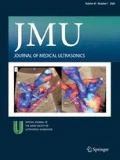Abstract
Spontaneous rupture is a life-threatening complication of hepatocellular carcinoma (HCC). Detecting active bleeding is critical. Color Doppler and contrast-enhanced ultrasonography (CEUS) with Levovist® are reported to be useful for detecting active bleeding. A few reports have described using Sonazoid® to detect bleeding in ruptured HCC. This report describes two distinctive patterns of bleeding from ruptured HCC observed in CEUS with Sonazoid®. Four patients with suspected HCC rupture were examined by gray-scale ultrasonography (US) and then CEUS with Sonazoid®. Two patterns of bleeding were observed with CEUS: jet-like extravasation (n = 2) and bubble leakage (n = 2). While contrast-enhanced computed tomography and angiography revealed active bleeding in only one patient, CEUS detected active bleeding and enabled the bleeding site to be estimated in all patients. Transcatheter arterial embolization was performed based on the findings of CEUS, and hemostasis was achieved in all patients. CEUS using Sonazoid® could demonstrate active bleeding as two patterns, and these findings enabled us to detect the rupture site of HCC more confidently than with other modalities.

Similar content being viewed by others
References
Yoshida H, Mamada Y, Taniai N, et al. Spontaneous ruptured hepatocellular carcinoma. Hepatol Res. 2016;46:13–21.
Miyamoto M, Sudo T, Kuyama T. Spontaneous rupture of hepatocellular carcinoma: a review of 172 Japanese cases. Am J Gastroenterol. 1991;86:67–71.
Aoki T, Kokudo N, Matsuyama Y, Liver Cancer Study Group of Japan, et al. Prognostic impact of spontaneous tumor rupture in patients with hepatocellular carcinoma: an analysis of 1160 cases from a nationwide survey. Ann Surg. 2014;259:532–42.
Ishida H, Konno K, Hamashima Y, et al. Sonographic and color Doppler findings of rupture of liver tumors. Abdom Imaging. 1998;23:587–91.
Tamai H, Oka M, Maeda H, et al. Contrast harmonic sonographically guided radio frequency ablation for spontaneous ruptured hepatocellular carcinoma. J Ultrasound Med. 2005;24:1021–6.
Matsumoto N, Ogawa M, Nakagawara H, et al. Clinical efficacy of contrast-enhanced ultrasonography (CEUS) in the diagnosis of ruptured hepatocellular carcinoma (HCC). J Med Ultrason. 2007;34:101–5.
Naganuma H, Funaoka M, Fujimori S, et al. Rupture of liver metastasis: report of a case with an emphasis on contrast-enhanced US. J Med Ultrason. 2001;2007:113–6.
Sugihara T, Koda M, Tokunaga S, et al. Contrast-enhanced ultrasonography revealed active thoracic bleeding. J Med Ultrason. 2001;2010:143–5.
Matono T, Koda M, Murawaki Y. Contrast-enhanced sonography with perflubutane revealing active bleeding as a complication of radiofrequency ablation. Hepatology. 2012;55:649–50.
Shiozawa K, Watanabe M, Ikehara T, et al. Usefulness of contrast-enhanced ultrasonography in the diagnosis of ruptured hepatocellular carcinoma. Clin J Gastroenterol. 2013;6:334–7.
Sato S, Tobita H, Miyake T, et al. Bleeding in abdominal cavity revealed by contrast-enhanced ultrasonography. J Med Ultrason. 2001;2013:289–91.
Kudo M, Kitano M, Sakurai T, et al. General rules for the clinical and pathological study of primary liver cancer, nationwide follow-up survey and clinical practice guidelines: the outstanding achievements of the Liver Cancer Study Group of Japan. Dig Dis. 2015;33:765–70.
Lubner M, Menias C, Rucker C, et al. Blood in the belly: CT findings of hemoperitoneum. Radiographics. 2007;27:109–25.
Baum ST. Arteriographic diagnosis and treatment of gastrointestinal bleeding. In: Baum ST, Pentecost MJ, editors. Abram’s angiography interventional radiology. 2nd ed. Philadelphia: Lippincott Williams and Wilkins; 2006. p. 488.
Chung YE, Kim KW. Contrast-enhanced ultrasonography: advance and current status in abdominal imaging. Ultrasonography. 2015;34:3–18.
Landmark KE, Johansen PW, Johnson JA, et al. Pharmacokinetics of perfluorobutane following intravenous bolus injection and continuous infusion of sonazoid in healthy volunteers and in patients with reduced pulmonary diffusing capacity. Ultrasound Med Biol. 2008;34:494–501.
Zhu GQ, Yu XX, Xiao CJ, et al. Hepatic artery embolization with Embosphere microspheres and Lipiodol for the treatment of massive bleeding due to ruptured primary liver cancer; clinical results in 25 cases. J Intervent Radiol. 2014;23:156–8 (Chinese, English abstract available)
Lai EC, Lau WY. Spontaneous rupture of hepatocellular carcinoma: a systematic review. Arch Surg. 2006;141:191–8.
Fuchizaki U, Miyamori H, Kitagawa S, Kaneko S. Radiofrequency ablation for life-threatening ruptured hepatocellular carcinoma. J Hepatol. 2004;40:354–5.
Author information
Authors and Affiliations
Corresponding author
Ethics declarations
Conflict of interest
The authors declare that they have no conflict of interest.
Human rights statements and informed consent
All procedures followed were in accordance with the ethical standards of the responsible committee on human experimentation (institutional and national) and with the Helsinki Declaration of 1975, as revised in 2008. Informed consent was obtained from all patients for being included in the report.
About this article
Cite this article
Sugihara, T., Koda, M., Okamoto, T. et al. Two patterns of contrast-enhanced ultrasonography with Sonazoid® in spontaneous rupture of hepatocellular carcinoma: a report of four cases. J Med Ultrasonics 45, 319–323 (2018). https://doi.org/10.1007/s10396-017-0812-7
Received:
Accepted:
Published:
Issue Date:
DOI: https://doi.org/10.1007/s10396-017-0812-7




